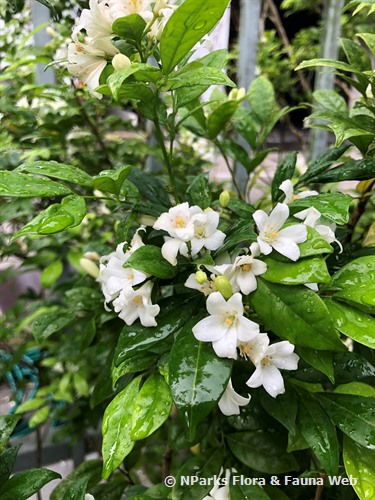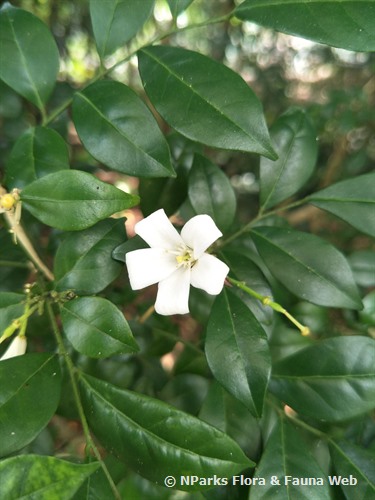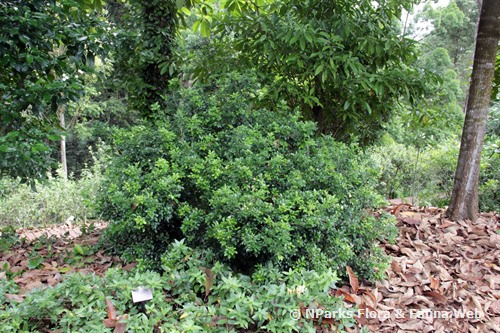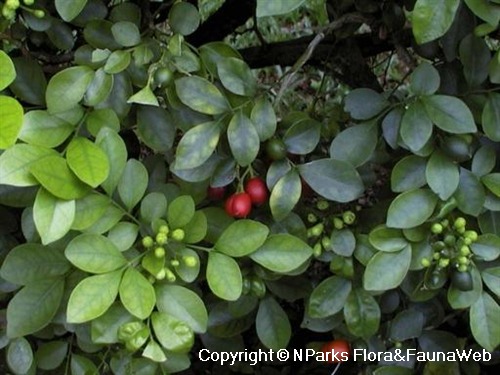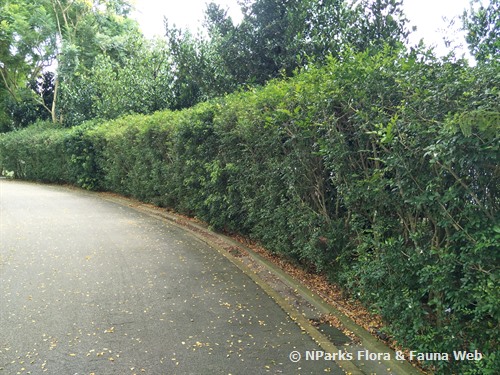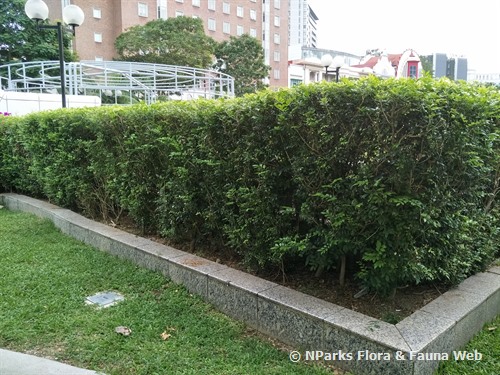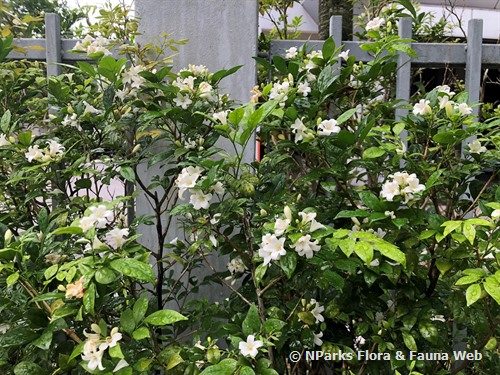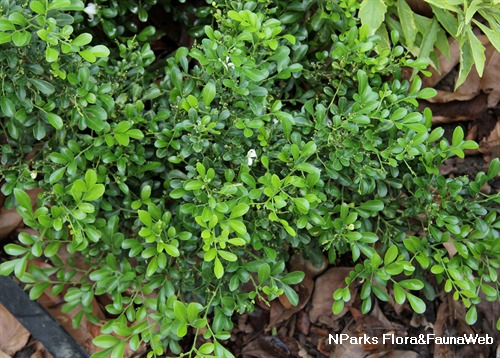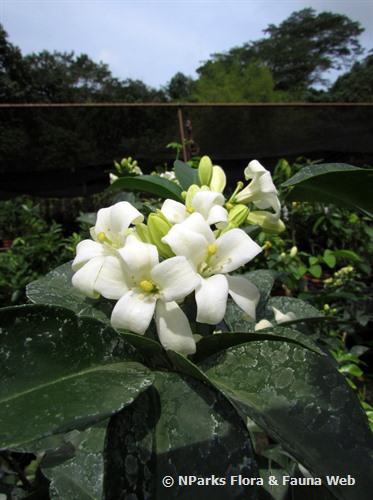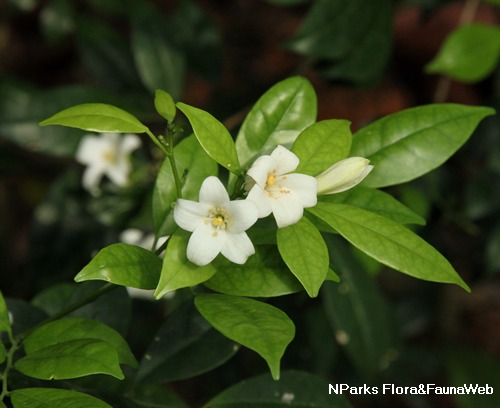
Back
Murraya paniculata (L.) Jack
| Family Name: | Rutaceae |
| Synonyms: | Chalcas exotica, Chalcas paniculata, Limonia malliculensis, Murraya exotica, Murraya japonensis |
| Common Name: | Orange Jasmine, Mock Lime, Kemuning, Mock Orange, China Box, Burmese Boxwood, Chinese Box, Kemuning Lada, Orange Jessamine, 九里香, 千里香 |
Murraya paniculata is a compact shrub with shiny, oval-shaped dark green leaves and clusters of white flowers with strong fragrance similar like citrus flowers, hence the common name. This free-flowering plant is commonly planted in parks and gardens as hedge or topiary.
Name
Classifications and Characteristics
| Plant Division | Angiosperms (Flowering Seed Plants) (Dicotyledon) |
|---|---|
| Plant Growth Form | Shrub |
| Lifespan (in Singapore) | Perennial |
| Mode of Nutrition | Autotrophic |
| Plant Shape | Shrubby |
| Maximum Height | 2.5 m to 3.5 m |
Biogeography
| Native Distribution | Southern & Southeast Asia, Northern Australia and New Caledonia. |
|---|---|
| Native Habitat | Terrestrial |
| Preferred Climate Zone | Tropical, Sub-Tropical / Monsoonal |
Description and Ethnobotany
| Growth Form | A fine textured, medium-sized shrub, that grows up to 8 m tall, but usually cultivated and maintained to about 2.5- 3.5 m tall. |
|---|---|
| Foliage | Leaves are evergreen, alternate, compound (with 3 - 7 leaflets), odd-pinnate. Leaflet is ovate-shaped, about 2 - 3 cm long, dark green and glossy. |
| Stems | Multi-stemmed, but can be trained to grow with a short, single stem. |
| Flowers | Flowers are white, flowers all year round and have a pleasant fragrance. Flowers are borne in clusters on the terminal or axillary stem and branches. |
| Fruit | Fruit ripen to red, oval, fleshy and measure about 1- 3 cm long. |
| Cultivation | Grow in rich and moist, well-drained loamy soil, under full sun but can also tolerate a wide range of soil. Can tolerate slight shade but flowers best under full sun. Plants can be grown in containers, propagated via seed or stem cutting. |
| Etymology | Genus Murraya is named in honor of Johan Andreas Murray (1740 - 1791), Professor of Botany at Gottingen. Species paniculata means with a branched-racemose or cymose inflorescence. |
| Ethnobotanical Uses | Medicinal: <i>M.paniculata</i> is commonly used in traditional medicine for treatment of diarrhea, abdominal pain, stomach ache, dysentery, headache, edema, thrombosis and stasis of blood (Dosoky et al., 2016). It is important to note that some therapeutic effects from traditional medicinal uses of plants are not currently supported or verified by scientific research. Cultural / Religious: Heritage Tree: There are 2 individuals of Murraya paniculata listed as Heritage Trees in Singapore. Both trees can be found in Changi, Andover Road. To find out more about these trees, please visit the Heritage Tree Register. |
Landscaping Features
| Landscaping | A hardy plant that is free flowering all year round with glossy dark green leaves, commonly planted as hedges or for screening. |
|---|---|
| Desirable Plant Features | Fragrant (Flowers) (Day), Ornamental Flowers |
| Landscape Uses | Hedge / Screening, Topiary, Parks & Gardens |
| Thematic Landscaping | Formal Garden |
Fauna, Pollination and Dispersal
| Fauna Pollination Dispersal Associated Fauna | Bird-Attracting |
|---|
Plant Care and Propagation
| Light Preference | Full Sun |
|---|---|
| Water Preference | Moderate Water |
| Rootzone Tolerance | Fertile Loamy Soils, Acidic (low pH) Soils, Alkaline high pH Soils |
| Propagation Method | Seed, Stem Cutting, Air-Layering |
| Maintenance Requirements Remarks | High maintenance is required if used for topiary landscapes or formal gardens. |
| Planting Distance | 90 cm to 150 cm |
Foliar
| Foliage Retention | Evergreen |
|---|---|
| Mature Foliage Colour(s) | Green |
| Mature Foliage Texture(s) | Smooth, Glossy / Shiny |
| Foliar Type | Compound (Odd-Pinnate) |
| Foliar Arrangement Along Stem | Alternate |
| Foliar Shape(s) | Non-Palm Foliage (Obovate) |
| Foliar Venation | Pinnate / Net |
| Foliar Margin | Entire |
| Leaf Area Index (LAI) for Green Plot Ratio | 4.5 (Shrub & Groundcover - Dicot) |
Floral (Angiosperm)
| Flower & Plant Sexuality | Bisexual Flowers |
| Flower Colour(s) | White |
|---|---|
| Flowering Period | Free-Flowering |
| Flowering Opening Time | Daytime |
| Flowering Habit | Polycarpic |
Fruit, Seed and Spore
| Mature Fruit Colour(s) | Red |
|---|---|
| Mature Fruit Texture(s) | Smooth |
| Seed Quantity Per Fruit | Few (1-5) |
References
| References | Dosoky NS, Satyal P, Gautam TP, Setzer WN. Composition and Biological Activities of Murraya paniculata (L.) Jack Essential Oil from Nepal. Medicines (Basel). 2016 Feb 26;3(1):7. doi: 10.3390/medicines3010007. PMID: 28930117; PMCID: PMC5456234. |
|---|
Image Repository
Others
| Master ID | 945 |
|---|---|
| Species ID | 2239 |
| Flora Disclaimer | The information in this website has been compiled from reliable sources, such as reference works on medicinal plants. It is not a substitute for medical advice or treatment and NParks does not purport to provide any medical advice. Readers should always consult his/her physician before using or consuming a plant for medicinal purposes. |

.jpg)
.jpg)
